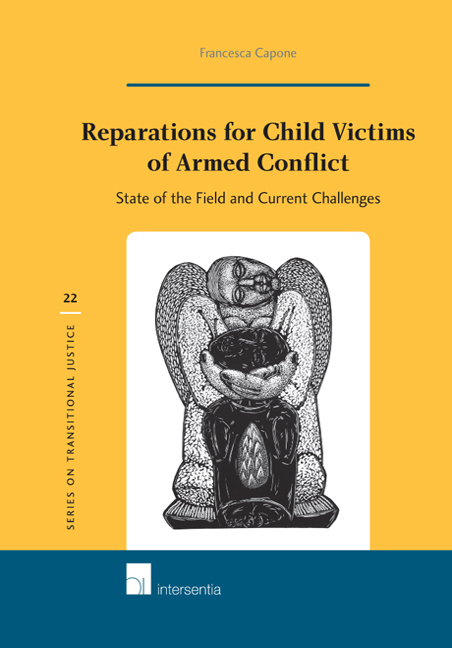Book contents
- Frontmatter
- Dedication
- Foreword
- About the Author
- Acknowledgements
- Contents
- Table of Cases
- Table of International Instruments
- List of Abbreviations
- Chapter 1 Setting the Scene
- PART I THE NORMATIVE AND THEORETICAL FRAMEWORK
- Chapter 2 Children as Victims of Armed Conflict
- Chapter 3 The Right to Reparation in International Law: Developments, Shortcomings and their Relevance to Child Victims of Armed Conflict.
- Chapter 4 Forms and Scope of Reparations for Child Victims of Armed Conflict
- PART II CURRENT APPLICATION OF THE PRINCIPLES AND NORMS
- Bibliography
- Index
Chapter 4 - Forms and Scope of Reparations for Child Victims of Armed Conflict
from PART I - THE NORMATIVE AND THEORETICAL FRAMEWORK
Published online by Cambridge University Press: 29 September 2018
- Frontmatter
- Dedication
- Foreword
- About the Author
- Acknowledgements
- Contents
- Table of Cases
- Table of International Instruments
- List of Abbreviations
- Chapter 1 Setting the Scene
- PART I THE NORMATIVE AND THEORETICAL FRAMEWORK
- Chapter 2 Children as Victims of Armed Conflict
- Chapter 3 The Right to Reparation in International Law: Developments, Shortcomings and their Relevance to Child Victims of Armed Conflict.
- Chapter 4 Forms and Scope of Reparations for Child Victims of Armed Conflict
- PART II CURRENT APPLICATION OF THE PRINCIPLES AND NORMS
- Bibliography
- Index
Summary
INTRODUCTION: OVERVIEW OF THE DIFFERENT FORMS OF REPARATION FOR CHILD VICTIMS
Reparations can take different forms as explained in the UNBPG. Whereas within the traditional international law framework the options envisaged are solely restitution, compensation and satisfaction, reparations for individuals or groups who have suffered from IHRL and IHL violations include also rehabilitation and guarantees of non-repetition. In addition to the specific kinds of reparation that can be awarded it is also important to discuss the scope and breadThof the measures available and their potential impact on child victims ‘current and future situation. As stressed by the Liberian TRC, ‘children expect to receive reparations as an acknowledgement of their suffering, a means to make up for lost out opportunities and as concrete assistance for their rebuilding of their shattered lives’. In the case of former child soldiers, the expectations placed on reparations are even more demanding:
Reparation orders and programmes in favour of child soldiers, should guarantee the development of the victims ‘personalities, talents and abilities to the fullest possible extent and, more broadly, they should ensure the development of respect for human rights and fundamental freedoms. For each child, the measures should aim at developing respect for their parents, cultural identity and language. Former child soldiers should be helped to live responsibly in a free society, recognising the need for a spirit of understanding, peace and tolerance, showing respect for equality between the sexes and valuing friendship between all peoples and groups.
On the one hand it is desirable for reparations to broaden their scope in order to better address victims ‘needs; however, on the other hand it is crucial to bear in mind that several factors come in to play when redress measures are designed and implemented. Furthermore, it is important to distinguish between reparations and other forms of aid and assistance to which child victims may also be entitled. Whereas reparations have a specific legal meaning and infer the commission of a violation, the existence of a causal link, and the recognition/ personification of the victim, assistance measures can be simply put in place to fill a gap in the States ‘capability of guaranteeing access to basic rights.
- Type
- Chapter
- Information
- Reparations for Child Victims of Armed ConflictState of the Field and Current Challenges, pp. 111 - 138Publisher: IntersentiaPrint publication year: 2017



